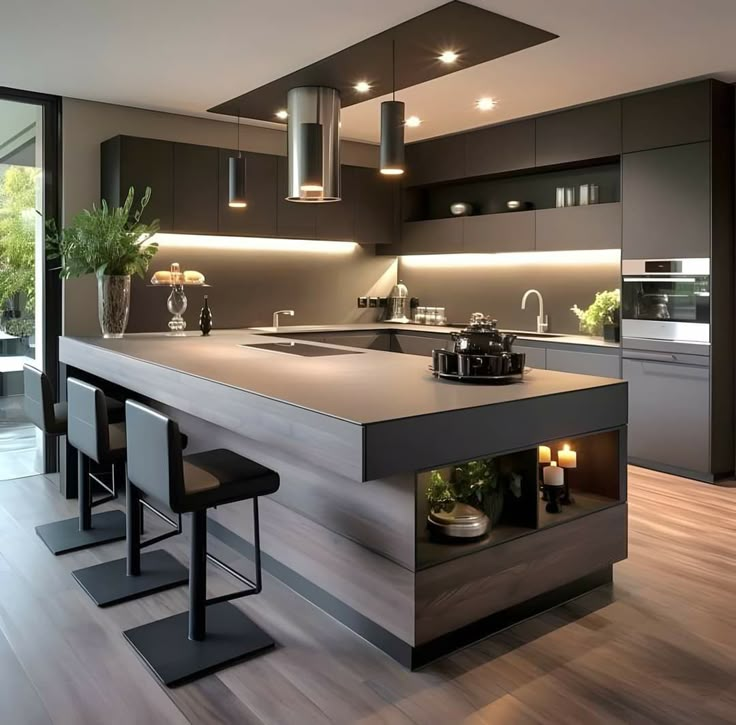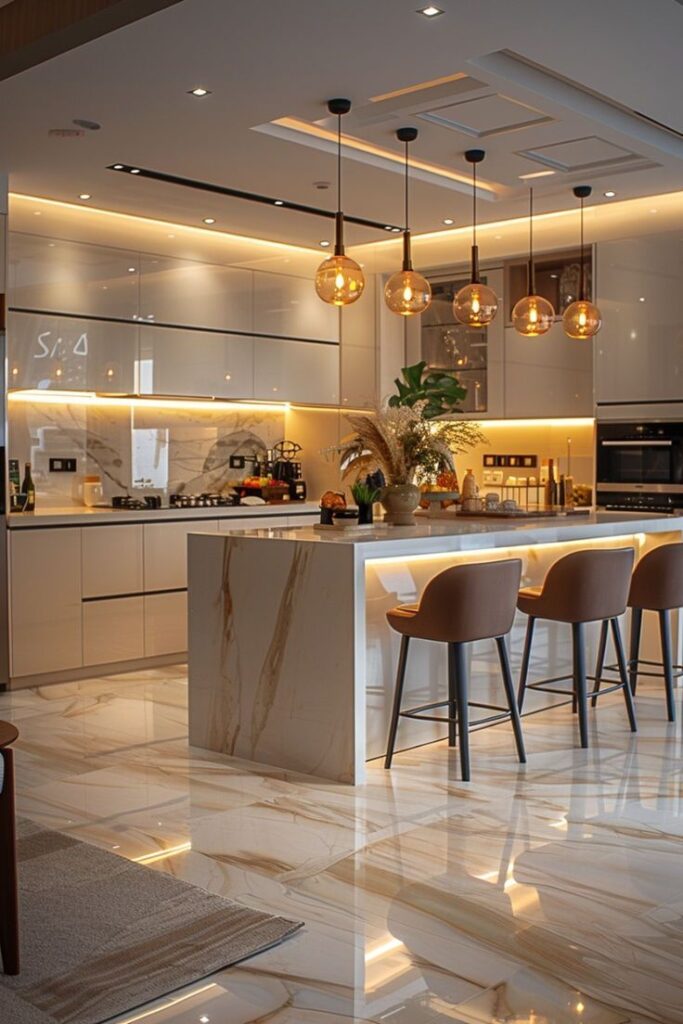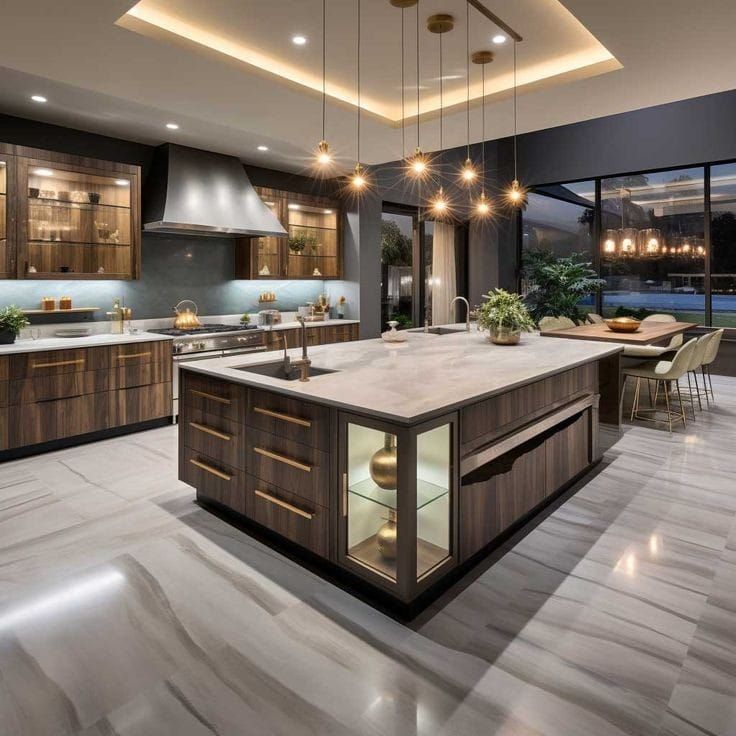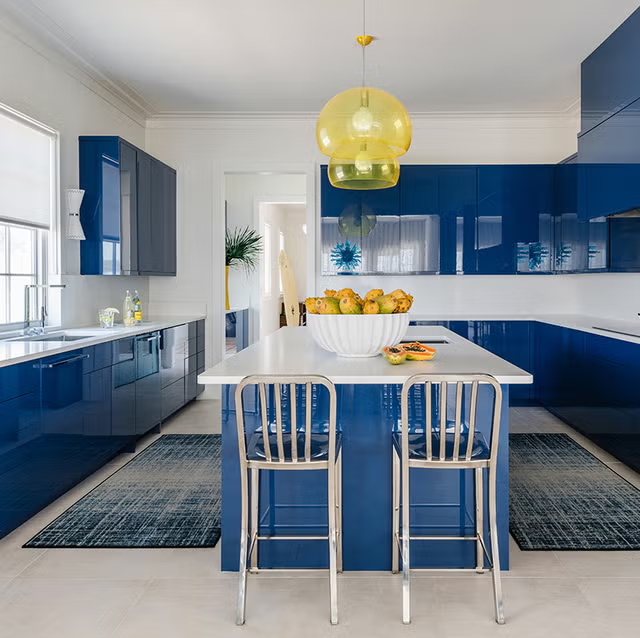Bold color schemes: say farewell to all-white kitchens.
The era of unadorned, whitewashed cooking spaces is receding rapidly. In 2025, homeowners are gravitating towards bold, vivid colors to infuse their living spaces with individuality and character. Consider incorporating deep emerald greens, rich aubergines, or warm ochres into cabinetry, which will contribute to a cozy yet sophisticated ambiance. These colors not only look aesthetically pleasing—they transform your kitchen into a reflection of your personal style.
Explanation of How Bright Colors Attract Attention
Vibrant hues serve as a focal point, transforming your kitchen into a lively conversation starter. They are particularly effective in open-plan homes, where the kitchen needs to make a statement without overpowering the overall layout. Combining jewel tones with sleek hardware, such as brass or matte black, enhances the overall appearance even more. According to a 2025 trend report by house beautiful, 68% of designers are shifting towards vibrant cabinetry to achieve a contemporary yet enduring aesthetic.
How to pull it off.
If you’re unsure about taking on a bold color, begin by painting a small area, such as an island or lower cabinets, in a vibrant hue while keeping the upper cabinets in a more neutral tone. For instance, my friend Sarah recently painted her island a deep navy, and it completely transformed her kitchen from dull to Instagram-worthy. Opt for long-lasting, robust paint that can withstand regular use, and combine vibrant hues with neutral surfaces such as quartz or marble.
Pros::
Cons:
Con:
Adds personality and warmth.
Can feel daunting if excessive.
Easy to modify with color.
Needs meticulous color coordination.
Stylish yet classic with the perfect hues.
May not attract all customers if marketing.
The ultimate hub: multifunctional kitchen islands.
Kitchen islands are no longer limited to food preparation—they are transforming into multifunctional hubs that cater to cooking, working, dining, and socializing. By 2025, islands have expanded in size, become more intelligent, and boast a plethora of features such as built-in cooktops, concealed storage compartments, and integrated seating arrangements. They’re the Swiss Army Knife of Kitchen Design.
The emergence of the multi-purpose island.
A versatile island serves multiple purposes in both spacious and compact kitchens. Designers point out that islands nowadays frequently incorporate hidden appliances like wine coolers or microwaves, making them perfect for hosting gatherings. According to the national kitchen and bath association, a staggering 75% of homeowners desire islands that can serve multiple functions, ranging from casual dining to home office activities.

Creating your ideal paradise.
Reflect on your way of life when arranging your island. If you enjoy entertaining guests, consider incorporating a built-in sink or bar area into your kitchen design. To accommodate quick meals or homework sessions, it is advisable for families to include seating arrangements. My neighbor, Tom, installed a pop-up power station on his island, and now it’s the preferred location for various activities, including coffee gatherings and video conferences. Choose sturdy materials such as butcher block or granite to withstand frequent use.
Comparison: conventional vs. Multi-functional islands.
Feature:
Standard island.
Island with Many Uses.
Objective:
Cooking, additional workspace.
Cooking, eating, labor, containment.
Storage:
Small storage compartments or storage units.
Concealed storage spaces, utility rooms.
Cost:
The price range for this service is between $2,000 and $5,000
$5,000–$15,000+
Adaptability:
Basic functionality.
Tailored for individual preferences.
Eco-friendly and fashionable: sustainable materials.
In 2025, sustainability is no longer just a trendy term—it’s an essential element in kitchen design. Homeowners are increasingly selecting sustainable materials such as reclaimed wood, bamboo, recycled glass, and low-VOC finishes to minimize their impact on the environment. These materials aren’t just beneficial for the environment, they also bring a distinct texture and warmth to your kitchen.
What are the benefits of being eco-friendly?
Eco-friendly kitchens are in line with the increasing desire for sustainable living. According to a 2025 decorilla report, 62% of homeowners emphasize the importance of materials that are both long-lasting and environmentally friendly. Incorporating reclaimed wood into cabinet construction or utilizing recycled glass for countertops not only adds a unique touch but also reduces waste. Furthermore, these materials frequently surpass their traditional counterparts in terms of durability.
Suggestions for Utilizing Environmentally Friendly Materials
Replace plastic-based products with materials that are environmentally friendly. For example, cork flooring is comfortable to walk on, environmentally friendly, and surprisingly stylish. I had the pleasure of visiting a friend’s kitchen that featured a bamboo island top, which was not only visually appealing but also durable and environmentally friendly. When searching for authentic products, look for certifications such as fsc (forest stewardship council) to verify their authenticity.
Eco-friendly material alternatives.

Reclaimed wood: adds a touch of rustic charm, making it ideal for cabinets or shelving.
Bamboo: rapid-growing, resilient, suitable for flooring or countertops.
Recycled glass: colorful, distinctive, excellent for backsplashes or counters.
Low-voc paints: minimize the release of harmful emissions, ensuring a healthy indoor environment.
Smart kitchen technology: culinary convenience.
Smart technology is revolutionizing kitchens, making them more efficient and user-friendly. In 2025, we can expect to see a wide range of tech innovations that simplify cooking and cleaning tasks, such as ovens with built-in Wi-Fi and faucets that can be controlled through voice commands. These advancements aren’t just fancy gadgets—they’re specifically created to seamlessly integrate into your everyday life.
The smart kitchen transformation.
Smart appliances not only save time and energy but also bring a touch of modernity to your home. Picture being able to preheat your oven remotely using your phone or receiving a grocery list directly from your fridge. According to Decorilla, 55% of new kitchen designs in 2025 will incorporate at least one smart appliance, with voice assistants like Alexa taking the lead.
Incorporating tech without the chaos.
Opt for devices that complement your style, such as a modern smart fridge with a touchscreen display. My cousin Lisa is a big fan of her voice-activated faucet, which she uses without touching it while multitasking in the kitchen. Begin by selecting one or two compatible devices, such as a smart oven or lighting, and ensure they can be controlled using a single app for effortless management.
Advantages and Disadvantages of Smart Kitchens.

Cons:
Con:
Saves time and energy.
Increased initial expenses.
Improves ease.
Acquiring Familiarity with Technology
Enhances productivity.
Potential for Software Errors.
Concealed kitchens: modern and streamlined.
For individuals seeking a minimalist and organized living space, concealed kitchens are a revolutionary concept. These designs conceal appliances behind cabinetry or sliding panels, resulting in a clean, minimalist appearance. Concealed kitchens are ideal for open-plan homes, as they maintain a stylish appearance while still serving their purpose effectively.
The rise of hidden kitchens.
Concealed kitchens provide a sleek, minimalist look that perfectly complements contemporary homes. According to designers at architectural digest, 70% of open-plan kitchen renovations in 2025 will focus on incorporating hidden appliances to ensure a seamless and visually appealing design. This trend is ideal for individuals who desire their kitchen to seamlessly blend into the overall ambiance of their living area.
How to attain the appearance.
Invest in panel-compatible appliances that seamlessly integrate with cabinetry. For instance, my coworker Mark installed a hidden dishwasher that resembles a cabinet door, and none of the guests ever suspect its presence. Install cabinets and garages without handles to conceal small gadgets. Achieve a minimalist aesthetic by incorporating a striking backsplash or a textured countertop to add visual intrigue.
Where to purchase hidden kitchen gadgets.

Premium panel-ready refrigerators and dishwashers.
Ikea: cost-effective adaptable wardrobe doors.
Bosch: stylish, combined home appliances for a reasonable price.
People also ask (paa) subsection.
What are the hottest kitchen trends for the year 2025?
In 2025, kitchens are characterized by vibrant colors, versatile islands, eco-friendly materials, cutting-edge technology, and hidden designs. These trends seamlessly merge fashion with functionality, catering to contemporary lifestyles that prioritize versatility and environmental consciousness.
How can I make my kitchen sustainable?
Choose eco-friendly materials such as bamboo, reclaimed wood, or recycled glass for your project. Utilize eco-friendly paints and power-conserving devices. Even small adjustments, such as using LED lights or setting up composting stations, can have a significant impact.
What is a secret kitchen?
A concealed kitchen conceals appliances behind cabinetry or panels, creating a sleek and minimalist aesthetic. Open-plan homes are particularly suitable for this type of flooring, as it helps to keep the space organized and functional without adding unnecessary clutter.
Where can I find ideas for kitchen designs?
To find inspiration, browse through platforms such as Pinterest, Houzz, or Architectural Digest for visual references. Explore showrooms or seek advice from designers for tailored suggestions. Online platforms like decorilla’s virtual design service can also ignite creativity.
What are the most effective equipment for a kitchen renovation?
For designing, utilize applications such as sketchup or roomsketcher. To find eco-friendly materials, consider visiting home depot, ikea, or local salvage yards that offer sustainable alternatives. Engage a licensed designer through nkba for professional advice.




